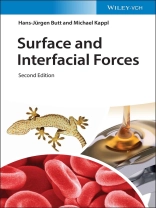A general introduction to surface and interfacial forces, perfectly combining theoretical concepts, experimental techniques and practical applications.
In this completely updated edition all the chapters have been thoroughly revised and extended to cover new developments and approaches with around 15% new content. A large part of the book is devoted to surface forces between solid surfaces in liquid media, and while a basic knowledge of colloid and interface science is helpful, it is not essential since all important concepts are explained and the theoretical concepts can be understood with an intermediate knowledge of mathematics. A number of exercises with solutions and the end-of-chapter summaries of the most important equations, facts and phenomena serve as additional tools to strengthen the acquired knowledge and allow for self-study.
The result is a readily accessible text that helps to foster an understanding of the intricacies of this highly relevant topic.
Mục lục
Preface xi
List of Symbols xiii
1 Introduction 1
2 Experimental Methods 5
2.1 Surface Forces Apparatus 6
2.1.1 Mica 8
2.1.2 Multiple Beam Interferometry 9
2.1.3 Friction Force Measurements 12
2.1.4 Surface Modification 13
2.2 Atomic Force Microscope 13
2.2.1 Force Measurements with the AFM 14
2.2.2 AFM Cantilevers 16
2.2.3 Calibration of the Spring Constant 18
2.2.4 Microfabricated Tips and Colloidal Probes 21
2.2.5 Friction Forces 22
2.2.6 Force Maps 24
2.2.7 Dynamic Modes 25
2.3 Optical Tweezers 26
2.3.1 Calibration 30
2.3.2 Multiple Traps 32
2.4 Total Internal Reflection Microscopy 33
2.5 Magnetic Tweezers 36
2.6 Summary 40
2.7 Exercises 41
3 van der Waals Forces 43
3.1 van der Waals Forces between Molecules 43
3.1.1 Coulomb Interaction 43
3.1.2 Monopole–Dipole Interaction 44
3.1.3 Dipole–Dipole Interaction 47
3.1.3.1 Keesom Interaction 48
3.1.3.2 Debye Interaction 49
3.1.3.3 London Dispersion Interaction 50
3.2 The van der Waals Force between Macroscopic Solids 52
3.2.1 Microscopic or Hamaker Approach 52
3.2.2 Macroscopic Calculation: Lifshitz Theory 57
3.2.3 Hamaker Constants 64
3.2.3.1 Calculation of Hamaker Constants 64
3.2.3.2 Combining Relations for Hamaker Constants 70
3.2.3.3 Table of Hamakar Constants 71
3.2.4 Surface Energy and Hamaker Constant 71
3.3 The Derjaguin Approximation 78
3.3.1 The General Equation 78
3.3.2 van der Waals Forces for Different Geometries 81
3.4 Retarded van der Waals Forces 82
3.4.1 Screening of van der Waals Forces in Electrolytes 84
3.5 Measurement of van der Waals Forces 85
3.6 The Casimir Force 88
3.6.1 Casimir Forces between Metal Surfaces 88
3.6.1.1 The Effect of Temperature 90
3.6.1.2 Finite Conductivity of Real Metals 90
3.6.1.3 Surface Roughness 91
3.6.1.4 Casimir Force for Nontrivial Geometries 92
3.6.2 Measurements of Casmir Forces 92
3.6.3 Critical Casimir Force 94
3.7 Summary 97
3.8 Exercises 98
4 Electrostatic Double-Layer Forces 99
4.1 The Electric Double Layer 99
4.2 Poisson–Boltzmann Theory of the Diffuse Double Layer 100
4.2.1 The Poisson–Boltzmann Equation 100
4.2.2 Planar Surfaces 101
4.2.3 The Full One-Dimensional Case 104
4.2.4 The Electric Double Layer around a Sphere 106
4.2.5 The Grahame Equation 107
4.2.6 Capacity of the Diffuse Electric Double Layer 108
4.3 Beyond Poisson–Boltzmann Theory 109
4.3.1 Limitations of the Poisson–Boltzmann Theory 109
4.3.2 The Stern Layer 111
4.4 The Gibbs Energy of the Electric Double Layer 112
4.5 The Electrostatic Double-Layer Force 114
4.5.1 General Equations 115
4.5.2 Electrostatic Interaction between Two Identical Surfaces 117
4.5.3 Electrostatic Interaction between Different Surfaces 118
4.6 The DLVO Theory 120
4.7 Electrostatic Forces in Nonpolar Media 123
4.8 Summary 128
4.9 Exercises 129
5 Capillary Forces 131
5.1 Equation of Young and Laplace 132
5.2 Kelvin Equation 135
5.2.1 Capillary Condensation 137
5.3 Young’s Equation 138
5.4 Capillary Forces Calculated with the Circular Approximation 139
5.4.1 Capillary Force between a Sphere and a Plane 140
5.4.2 Two Different Spheres 144
5.4.3 Other Geometries 146
5.4.4 Assumptions and Limits 148
5.5 Influence of Roughness 150
5.6 Kinetics of Capillary Bridge Formation and Rupture 152
5.7 Capillary Forces in Immiscible Liquid Mixtures and Other Systems 155
5.8 Normal Forces Acting on a Particle at a Liquid Interface 157
5.9 Lateral Forces between Particles at a Fluid Interface 160
5.10 Summary 164
5.11 Exercises 165
6 Hydrodynamic Forces 167
6.1 Fundamentals of Hydrodynamics 167
6.1.1 The Navier–Stokes Equation 167
6.1.2 Laminar and Turbulent Flow 170
6.1.3 Creeping Flow 171
6.2 Hydrodynamic Force between a Solid Sphere and a Plate 172
6.2.1 Force in Normal Direction 172
6.2.2 Force on a Sphere in Contact with a Plate in Linear Shear Flow 178
6.2.3 Motion of a Sphere Parallel to a Wall 179
6.3 Hydrodynamic Boundary Condition 182
6.4 Gibbs Adsorption Isotherm 183
6.5 Hydrodynamic Forces between Fluid Boundaries 185
6.6 Summary 189
6.7 Exercises 190
7 Interfacial Forces between Fluid Interfaces and across Thin Films 191
7.1 Overview 191
7.2 The Disjoining Pressure 193
7.3 Drainage 194
7.3.1 Vertical Foam Films 194
7.3.2 Horizontal Foam Films 197
7.4 Thin Film Balance 199
7.5 Interfacial Forces across Foam and Emulsion Films 202
7.5.1 Shape of a Liquid Film 202
7.5.2 Quasiequilibrium 203
7.5.3 Rupture 207
7.6 Thin Wetting Films 208
7.6.1 Stability of Thin Films 212
7.6.2 Rupture of Thin Films 214
7.7 Summary 216
7.8 Exercises 217
8 Contact Mechanics and Adhesion 219
8.1 Surface Energy of Solids 220
8.1.1 Relation between Surface Energy and Adhesion Energy 222
8.1.2 Determination of Surface Energies of Solids 223
8.2 Contact Mechanics 225
8.2.1 Elastic Contact for a Flat Punch 226
8.2.2 Adherence of a Flat Punch (Kendall) 229
8.2.3 Elastic Contact of Spheres: Hertz Model 230
8.2.4 Adhesion of Spheres: JKR Theory 232
8.2.5 Adhesion of Spheres: DMT Theory 236
8.2.6 Adhesion of Spheres: Maugis Theory 239
8.3 Influence of Surface Roughness 242
8.4 Elastocapillarity 244
8.4.1 Surface Patterns for Soft Materials 244
8.4.2 Drop on deformable surface 244
8.4.3 Contact of spheres to soft surfaces 245
8.5 Adhesion Force Measurements 245
8.6 Summary 248
8.7 Exercises 249
9 Friction 251
9.1 Macroscopic Friction 252
9.1.1 Dry Friction 252
9.1.1.1 Amontons’ and Coulomb’s Law 252
9.1.1.2 Sliding on Ice 259
9.1.1.3 Static, Kinetic, and Stick–Slip Friction 260
9.1.2 Friction and Adhesion 262
9.1.3 Rubber Friction 263
9.1.4 Rolling Friction 269
9.1.5 Techniques to Measure Friction 271
9.2 Lubrication 272
9.2.1 Hydrodynamic Lubrication 273
9.2.1.1 Elastohydrodynamic Lubrication 276
9.2.2 Boundary Lubrication 279
9.3 Microscopic Friction: Nanotribology 280
9.3.1 Single Asperity Friction 280
9.3.2 Atomic Stick–Slip 282
9.3.3 Velocity Dependence of Nanoscale Friction 289
9.3.4 Superlubricity 290
9.3.4.1 Structural Superlubricity 291
9.3.4.2 Static Superlubricity 292
9.3.4.3 Dynamic Superlubricity 292
9.3.4.4 Thermal Superlubricity 293
9.3.5 Thin Film Lubrication 293
9.4 Summary 295
9.5 Exercises 296
10 Solvation Forces and Non-DLVO Forces in Water 297
10.1 Solvation Forces 297
10.1.1 Contact Theorem 297
10.1.2 Solvation Forces in Simple Liquids 298
10.1.3 Solvation Forces in Liquid Crystals 302
10.2 Non-DLVO Forces in an Aqueous Medium 304
10.2.1 Hydration Forces 305
10.2.2 Hydrophobic Force 308
10.2.2.1 The Hydrophobic Effect 308
10.2.2.2 Hydrophobic Forces 310
10.3 The Interaction between Lipid Bilayers 316
10.3.1 Lipids 316
10.3.2 The Osmotic Stress Method 318
10.3.3 Forces between Lipid Bilayers 320
10.3.3.1 Undulation Forces 321
10.3.3.2 Protrusion Forces 323
10.4 Force between Surfaces with Adsorbed Molecules 325
10.5 Summary 327
10.6 Exercises 328
11 Surface Forces in Polymer Solutions and Melts 329
11.1 Properties of Polymers 329
11.2 Polymer Solutions 334
11.2.1 Ideal Chains 334
11.2.2 Real Chains in a Good Solvent 336
11.2.3 Stretching Individual Chains 338
11.3 Steric Repulsion 340
11.4 Polymer-Induced Forces in Solutions 349
11.5 Bridging Attraction 353
11.6 Depletion and Structural Forces 357
11.7 Interfacial Forces in Polymer Melts 359
11.8 Summary 361
11.9 Exercises 362
12 Solutions to Exercises 363
Chapter 2 363
Chapter 3 364
Chapter 4 365
Chapter 5 367
Chapter 6 370
Chapter 7 372
Chapter 8 373
Chapter 9 374
Chapter 10 375
Chapter 11 377
Bibliography 381
Index 431
Giới thiệu về tác giả
Hans-Jürgen Butt studied physics in Hamburg and Göttingen, Germany. Then he went to the Max-Planck-Institute of Biophysics in Frankfurt. After receiving his Ph D in 1989 he went as a post-doc to Santa Barbara, California, using the newly developed atomic force microscope. From 1990–95 he spent as a researcher back in Germany at the Max-Planck-Institute for Biophysics. In 1996 he became associate professor for physical chemistry at the University Mainz, three years later full professor at the University of Siegen. Two years later he joined the Max-Planck-Institute of Polymer Research in Mainz and became director for Experimental Physics.
Michael Kappl received his Ph D thesis from the Max-Planck-Institute of Biophysics in Frankfurt and worked at the University of Mainz and Siegen. Since 2002 he is group leader at the MPIP, working in the fields of surface forces, wetting and characterization of mechanical properties on the micro- and nanoscale.











